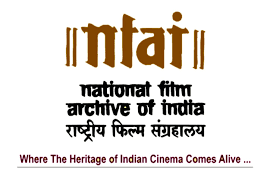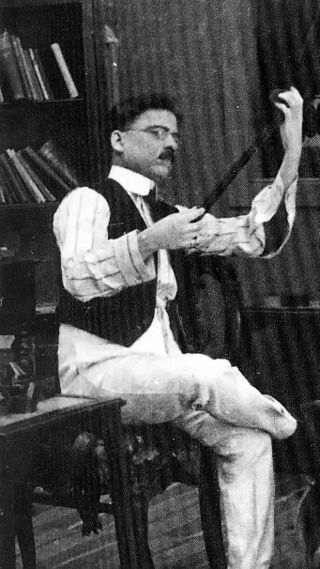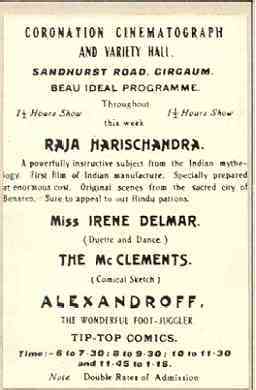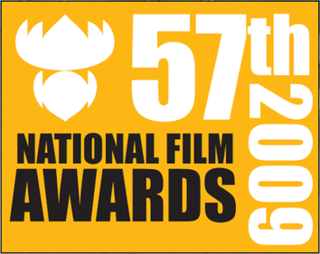Related Research Articles

The Dadasaheb Phalke Award is India's highest award in the field of cinema. It is presented annually at the National Film Awards ceremony by the Directorate of Film Festivals, an organisation set up by the Ministry of Information and Broadcasting. The recipient is honoured for their "great and outstanding contribution to the growth and development of Indian cinema" and is selected by a committee consisting of eminent personalities from the Indian film industry. The award comprises a Swarna Kamal medallion, a shawl, and a cash prize of ₹1,000,000 (US$12,000).

The National Film Archive of India (NFAI) was established as a media unit of the Ministry of Information and Broadcasting in February 1964. It was a member of the International Federation of Film Archives.

Dhundiraj Govind Phalke, popularly known as Dadasaheb Phalke, was an Indian producer-director-screenwriter, known as "the Father of Indian cinema".

Raja Harishchandra is a 1913 Indian silent film directed and produced by Dadasaheb Phalke. It is often considered the first full-length Indian feature film. Raja Harishchandra features Dattatraya Damodar Dabke, Anna Salunke, Bhalchandra Phalke. and Gajanan Vasudev Sane. It is based on the legend of Harishchandra, with Dabke portraying the title character. The film, being silent, had English, Marathi, and Hindi-language intertitles.

Marathi Cinema, also known as Marathi film industry, is the segment of Indian cinema dedicated to the production of motion pictures in the Marathi language widely spoken in the state of Maharashtra. It is based in Mumbai. It is the oldest film industry of India and one of the leaders in filmmaking in the Indian film industry.
D. D. Dabke or Dattatraya Damodar Dabke was an actor in the first ever Indian full length silent film Raja Harishchandra, directed by Dadasaheb Phalke in 1913. He co-starred with Anna Salunke. He acted in three more movies Satyavadi Raja Harishchandra (1917), Lanka Dahan (1917), Shri Krishna Janma (1918) and later became a cinematographer, as well as a director. He directed the 1924 remake of Raja Harishchandra
Coronation Cinematograph and Variety Hall was a hall in the Girgaon area of south Mumbai, India, used for variety entertainment shows, dramas and to screen movies.

Satyawadi Raja Harishchandra is a 1917 silent black and white Indian film based on Hindu mythology, directed by Rustomji Dhotiwala. It was produced by J. F. Madan's Elphinstone Bioscope. Credited as the first remake in Indian cinema, the film is a remake of the first Indian feature film, Raja Harishchandra (1913) and was also inspired by an Urdu language drama, Harishchandra. The film is based on the mythological story of a Hindu King Harishchandra, the 36th king of the Solar Dynasty, who donated his entire kingdom and sold himself and his family to keep the promise given to the sage Vishvamitra in the dream. It is also the first feature film made in Calcutta. The intertitles used in the film were in Bengali language as the film was a silent film. The film was released on 24 March 1917 at New Tent Maidan, Calcutta.

Harishchandrachi Factory is a 2009 Indian Marathi-language biographical film written and directed by Paresh Mokashi. It is about Dadasaheb Phalke, who made the first Indian feature film Raja Harishchandra (1913), and starring Nandu Madhav as him and Vibhavari Deshpande as his wife Saraswati. Harishchandrachi Factory focuses on the struggle Phalke faced during its production.
The Indian Animation Industry encompasses traditional 2D animation, 3D animation and visual effects for feature films. In 1956, Disney Studios animator Clair Weeks, who had worked on Bambi, was invited to Films Division of India in Mumbai to establish and train the country's first animation studio as part of the American technical co-operation mission. He trained a core group of Indian animators, whose first production was a film called The Banyan Deer (1957). Veteran animator Ram Mohan started his career at Films Division's Cartoon Unit.

The 57th National Film Awards, presented by Directorate of Film Festivals, the organisation set up by Ministry of Information and Broadcasting, India to felicitate the best of Indian Cinema released in the year 2009.
Harishchandra is an Indian king mentioned in ancient Hindu religious texts.
The 1st National Film Awards, presented by Ministry of Information and Broadcasting, India to felicitate the best of Indian Cinema released in the year 1953. Ceremony took place at Vigyan Bhavan, New Delhi on 10 October 1954 and awards were given by then President of India, Rajendra Prasad.

The 59th National Film Awards, presented by the Directorate of Film Festivals, honoured the best of Indian cinema for 2011 and took place on 3 May 2012 at Vigyan Bhavan, New Delhi. Awards were presented in 38 categories in the Feature Films section, 20 categories in the Non-Feature Films section and two categories for the Best Writing on Cinema section; 41 jury members chose the winners from 392 entries. The ceremony was hosted by actors Vinay Pathak and Saumya Tandon. Awards were presented by the Vice-President of India, Mohammad Hamid Ansari. The ceremony was broadcast live on three television channels, eleven All India Radio stations, and webcast live.

Paresh Mokashi is an Indian filmmaker, producer, actor and Theatre director-producer; working predominantly in Marathi cinema and Marathi theatre. He started working as a backstage worker for theatre and did few minor roles for plays as well as films. Mokashi made his directorial debut for theatre with the Marathi play, Sangeet Debuchya Mulee in 1999. He continued to work for theatre and made his directorial debut for cinema with the 2009 Marathi feature film, Harishchandrachi Factory. The film depicts the making of India's first full-length feature film, Raja Harishchandra (1913), made by Dadasaheb Phalke. The film was acclaimed critically and won several awards. It was also selected as India's official entry to 82nd Academy Awards in the Best Foreign Language Film category.

Shree Pundalik, which was released on 18 May 1912 at the Coronation Cinematograph, Girgaum, Mumbai, is sometimes considered the first feature-length Indian film by a minority. The government of India and most scholarly sources consider Raja Harishchandra to be the first Indian feature film, and detractors argue Pundalik was only a photographic recording of a popular play. It was produced and directed by Dadasaheb Torne.
Satyavadi Raja Harishchandra is a 1917 silent black and white Indian short film directed and produced by Dhundiraj Govind Phalke. The film is a shorter version of the first Indian feature film, Raja Harishchandra (1913), also directed and produced by Phalke. The intertitles used in the film were in Marathi language as the film was a silent film. The film is based on the mythological story of a Hindu King Harishchandra, the 36th king of the Solar Dynasty, who donated his entire kingdom and sold himself and his family to keep the promise given to the sage Vishvamitra in the dream.

Lanka Dahan is a 1917 Indian silent film directed by Dadasaheb Phalke. Phalke also wrote the film based on an episode of the Hindu epic Ramayana, credited to Valmiki. The film was Phalke's second feature film after the 1913 Raja Harishchandra, which was the first Indian full-length feature film. Phalke also directed various short films in between.
Mohini Bhasmasur is a 1913 Indian mythological film directed by Dadasaheb Phalke and starring Kamlabai Gokhale and Durgabai Kamat. It is India's and Phalke's second full-length feature film. Mohini Bhasmasur is the first Indian film to have a female actor. In Raja Harischandra, India's and Phalke's first film, the role of the female was played by Anna Salunke, a male.

Anna Hari Salunke, also known as A. Salunke and Annasaheb Saluke, was an Indian actor who performed female roles in very early Indian cinema and also a cinematographer. He is the first person to perform as a heroine in Indian cinema when he played the role of Queen Taramati in Dada Saheb Phalke's first full-length film, Raja Harishchandra (1913). In 1917, Salunke became the first to play a double role in Indian cinema, by playing the roles of both the hero and heroine in Lanka Dahan.
References
- 1 2 "Tholu Bommalata". aptdc.gov.in. Andhra Pradesh tourism. Archived from the original on 27 October 2016. Retrieved 30 October 2016.
- ↑ "Puppet Forms". ccrtindia.gov.in. Centre for Cultural Resources and Training. Retrieved 30 October 2016.
The puppets are large in size and have jointed waist, shoulders, elbows and knees. They are coloured on both sides. Hence, these puppets throw coloured shadows on the screen.
- 1 2 3 4 5 6 7 Prof. Tenali, Phani; Agarwal, Swati. "Long Ago". dsource.in. The Story of Indian Animation. D'source. Retrieved 30 October 2016.
- 1 2 3 Torcato, Ronita (25 December 2009). "Once Upon a Magic Lantern". www.thehindubusinessline.com. Business Line, The Hindu. Retrieved 30 October 2016.
- 1 2 "Silent Films of India". www.culturopedia.com. Indian Cinema. Culturopedia. Archived from the original on 23 October 2016. Retrieved 30 October 2016.
- ↑ The Editors of Encyclopædia Britannica. "Dadasaheb Phalke". britannica.com. Encyclopædia Britannica. Retrieved 30 October 2016.
{{cite web}}:|last=has generic name (help) - 1 2 Sen, Jayanti (1 October 1999). "India's Growing Might". awn.com. Animation World Network. Retrieved 30 October 2016.
Finally, after a lot of effort and struggle, he did make his first film, The Growth Of A Pea Plant, and again it was using stop-motion, i.e. time-lapse photography. So, did anyone realize that 1912 officially marked the beginning of Indian animation using the animation technique of time-lapse photography?
- 1 2 Dr. Lent, John A. (August 1998). "Ram Mohan and RM-USL: India's Change Agents of Animation". awn.com. Animation World Magazine, Animation World Network. Retrieved 30 October 2016.
In 1915, the father of Indian cinema, Dhumdiraj Govind Phalke, produced the animated Agkadyanchi Mouj (Matchsticks' Fun), followed by Laxmicha Galicha (animated coins), and Vichitra Shilpa (again, inanimate animation). Because the war in Europe had slowed imports, including film, Phalke was forced into making shorter works than features, so he resorted to cartoons and documentaries.
- ↑ Wright, Jean Ann (2013). "Chapter 2: The History of Animation". Animation Writing and Development. Focal Press. ISBN 9781136144059 – via safaribooksonline.com.
Early in the twentieth century Dhundiraj Govind "Dadasaheb" Phalke made the first animated film in India, Agkadyanchi Mouj. He had probably seen Emile Cohl's matchstick film.
- 1 2 "Glimpses of Indian Animation", directed by R. Swamy, Films Division of India, 1997. Accessed on 17 October 2016. May have originally been titled "The Complete History of Indian Animation".
- ↑ Dr.Lent, John A. (August 1998). "Ram Mohan and RM-USL: India's Change Agents of Animation". awn.com. Animation World Magazine (issue 3.5), Animation World Network. Retrieved 30 October 2016.
The first Indian animated film with a soundtrack, On a Moonlit Night, was released in 1934, and credited to composer and orchestra leader R.C. Boral.
- 1 2 3 Sen, Jayanti (1 October 1999). "The Neglected Queen of Indian Animation". awn.com. Animation World Network. Retrieved 30 October 2016.